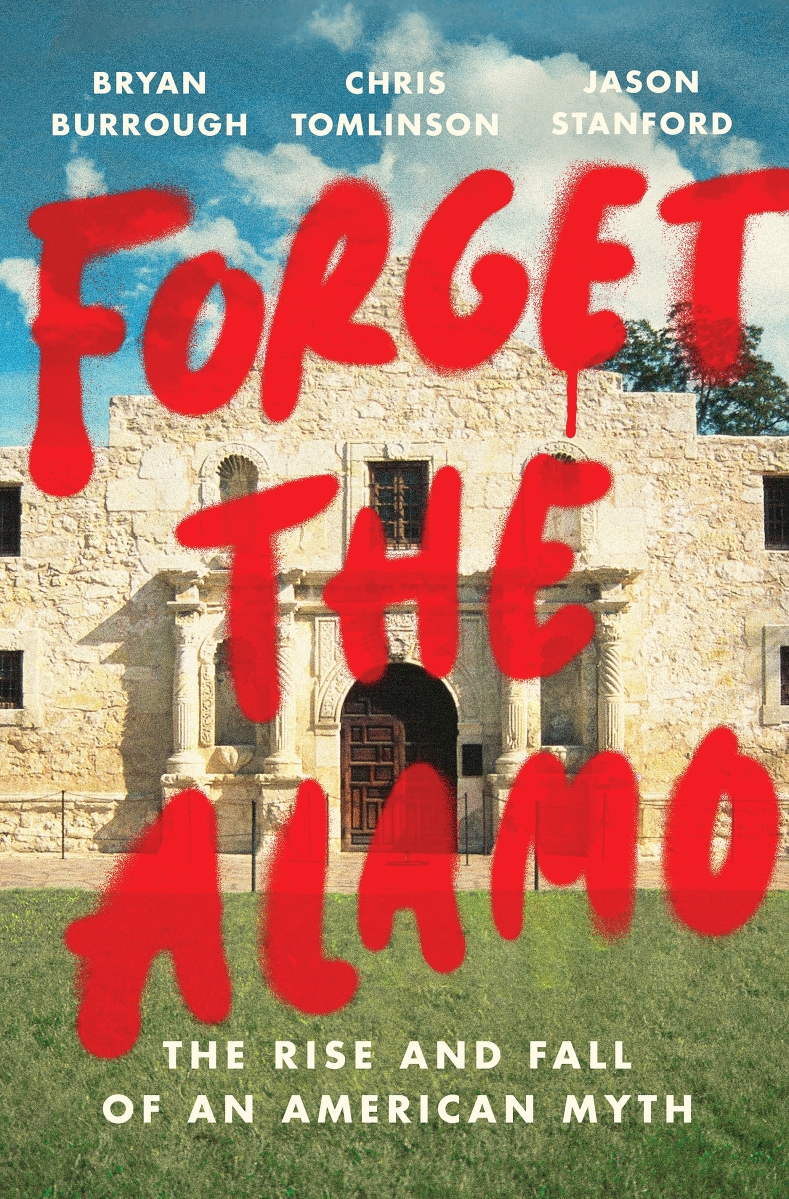Last month, writer Chris Tomlinson, along with Bryan Burrough and Jason Stanford, released Forget The Alamo, The Rise and Fall of an American Myth, the latest case study exploring the oil-and-water relationship between state politics and history museums. At the heart of the issue is the conservative movement’s bent towards historic revisionism. It centers on, of all places, the Alamo, San Antonio’s all-important historic site whose development has become a lightning rod in Texas politics for the past few decades. The story has it all: militiamen, psychic-authenticated artifacts, an American myth and Phil Collins. Bet you didn’t see that coming.
When did you get started on the book?
It started a little over two years ago. I’m a columnist for the San Antonio Express and the Houston Chronicle where I write about business. I was writing about the brand of Texas. The premise was that the state is 42 percent Anglo and maybe we need to reconsider the tall white cowboy as our symbol. As a line, I wrote that the “defenders of the Alamo were defending slavery as much as liberty.” I mentioned this to Jason Stanford and Bryan Burrough over breakfast and they were surprised to hear about the true history. Brian slapped his hand down and said, ‘I think there’s a book here.’ Two years ago this month we signed a contract with Penguin and set out. We thought it was going to be a light essay and, with all things history, it got a lot more complicated.
The light essay turned into how many pages?
Forget The Alamo came out on June 8 at 386 pages in a hardback. The response has been shockingly positive. Jeff Long wrote a book, Duel of Eagles, that covers much of this, and he was pilloried by Texas media and Texas society. We were braced for the same response but I think the academics have caught up. A new generation has kind of aged with a more realistic understanding of history and I would say it’s been 90 percent supportive.
Until you got blackballed by Lt Gov Dan Patrick and the Bob Bullock Texas State History Museum. What happened there?
The museum staff invited us to speak, and we asked them to team up with the Writer’s League of Texas. At the last minute, under pressure from Patrick, the museum notified the League they were dropping out due to political pressure. Patrick later crowed about it on Twitter. This is clearly government interference in our right to speak, and we are demanding the museum restore the event as originally planned.
At the heart of this controversy is the mythologized version of the Alamo. What is the myth?
The myth is that a group of Texian Anglo-Saxons took up arms against an oppressive dictator who was threatening their lives and their livelihood. In San Antonio, as the dictator’s army marched forward, these 200 men fought to their death to slow down the army so that Sam Houston would have time to get organized and be able to defeat Santa Anna at the battle of San Jacinto. This is a Biblical story: here are these men who sacrificed themselves so others may live. Almost none of that is true. Sam Houston had ordered the fighters at the Alamo to destroy it and come join his forces so that they could rally and draw a line at the Colorado River instead of at the dusty plains of San Antonio. We don’t know why William B. Travis and James Bowie didn’t follow that order. We do know they were surprised by Santa Anna – they were not expecting the army to advance from Mexico until the spring grasses had grown, usually in April. Santa Anna showed up two months early and surprised them. They had no intention of quelling an army they didn’t even know was coming. They attempted twice to negotiate a surrender. While Travis wrote letters, he was also trying to convince Santa Anna to let him and his men leave quietly without fighting. Santa Anna replied, ‘No, you will be my prisoners and you will suffer for the crime of piracy. You are foreigners, unauthorized in my country, trying to steal my land,’ which is true. Then, when there was the attack, we know at least one-third to one-half of the Anglos ran out of the Alamo trying to save their lives. They did not fight valiantly to the death. And lastly, all this happened while Santa Anna was waiting for the rest of his army to catch up. He was four days behind schedule not because of the battle, but because he had a division of troops running late from Mexico. So there was no delay in his advance. The biggest lie is, of course, what they were fighting for. Santa Anna had given the Anglos everything they wanted: no tax, free land, a light hand in terms of Mexican soldiers being in their communities. The one thing he would not tolerate was slavery. And if Mexico banned slavery, the Anglos would have gone broke, there was no way they could have survived. That was the root cause for the fight and the reason the people were fighting.
And what is the real story of the Alamo that should be told?
The whole story talks about all 300 years of life around this area. It starts with the early Spanish settlement and the conversion of Native Americans to Christianity, which is the reason why there are 1,800 Native Americans buried in front of the Alamo under the street. They want their cemetery to be represented as a cemetery, which the state has refused to do. I think we have to talk about the root cause of the conflict, why it was so important for Anglos to keep slavery legal in Texas and how that motivated them. I think we have to talk about how not only did American illegal immigrants die fighting for the right to hold slaves, but hundreds of young Mexican men died at the Alamo trying to defend their country from invaders who had captured part of their sovereign nation. That Santa Anna was a brutal dictator and a horrible person, and Mexico was politically a mess – that has to be a part of the story. But then lastly, the Alamo has become this symbol of manifest destiny and the white supremacy that goes along with that. It has been coopted to justify a lot of horrible things, including the massacre of Mexican Americans along the border in the early 1900s.
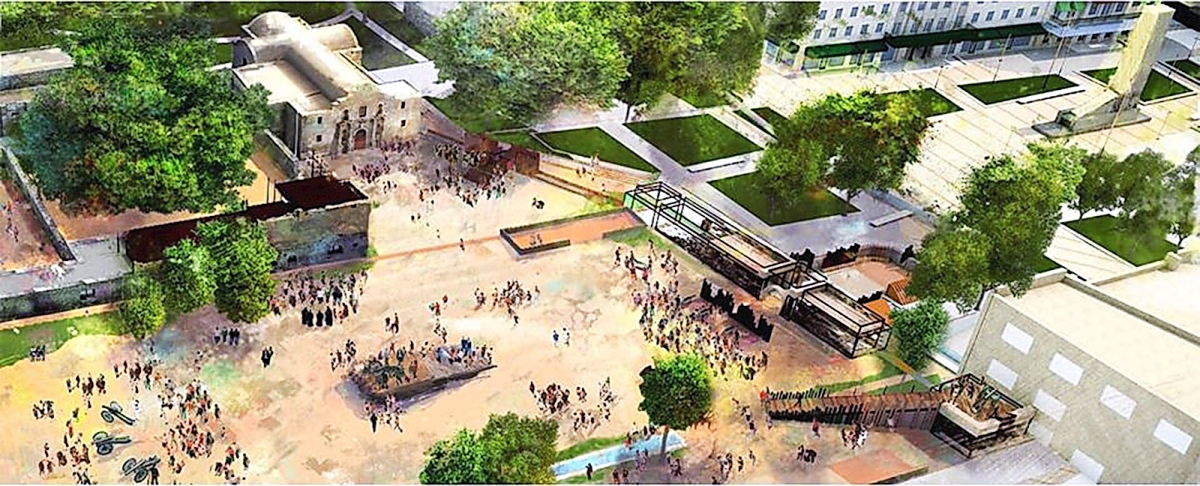
The Alamo posted a new rendering on its Facebook page, showing what part of the plaza might look like in 2024, if the project moves forward as planned. The illustration includes an interpretation of a second story of the Long Barrack as it existed in 1836; a spatial representation of the Low Barrack and Main Gate along the south wall of the mission-fort; and a ramp and platform as it appeared in 1836, at the southwest corner of the compound, where the Alamo garrison’s largest cannon was fired during the siege and battle.
Now we have a big development proposal to restore Alamo Plaza. Tell me how and why this whole thing started. Where was the funding going to come from?
The catalyst for all of this was the Phil Collins donation of 250 lots of Alamo artifacts. That donation was secured before the restoration was conceptualized.
The original plan was a $450 million restoration of the Alamo compound to get it as close as possible to the original 1836 layout. That was going to involve knocking down Nineteenth and early Twentieth Century buildings and replacing them with a three-story museum with a rooftop deck, restoring the Long Barrack – which is where most of the fighting took place – and giving you a sense of this huge compound that 186 men were trying to defend against a force of 3,000. This proposal was immediately rejected by just about everyone except the Land Office and George P. Bush. It would require shutting down one of the most important plazas in San Antonio to the public. It would destroy the Woolworth building and it did not recognize the Native Americans buried in front of the chapel and the Long Barrack. It was also a lot of money to spend in America’s most-impoverished large city. Most of the money, 85 percent, was supposed to come from private donations. So that means they’re competing with other good causes and other museums around the state. The other problem was this proposal focused mostly on the 13-day battle and ignored the other 300 years of history.
The state knew they had a problem. Visitation at the Alamo was poor because the Daughters of the Republic of Texas had only focused on the chapel and effectively turned it into a mausoleum – it was not a museum. The Long Barrack, which had originally been two stories, was now only one story, and was too small for a museum. And the Daughters had spent most of their time and money to build out the gift shop to get more money. People had been complaining about the Alamo experience since the 1970s. The state Land Commissioner didn’t have anything to get politicians and lawmakers excited about, or a cause to boost tourism. That’s when a Land Office employee asked Collins to donate his collection and he said, ‘Only if you build a museum to house my collection and I don’t want it broken up.’ With that donation in hand, the Land Commission then went out raising money, contacting donors and rallying legislators.
The Land Commissioner who obtained the collection was Jerry Patterson, but he was out of office six months later and George P. Bush replaced him. Most of the fundraising was done by Bush.
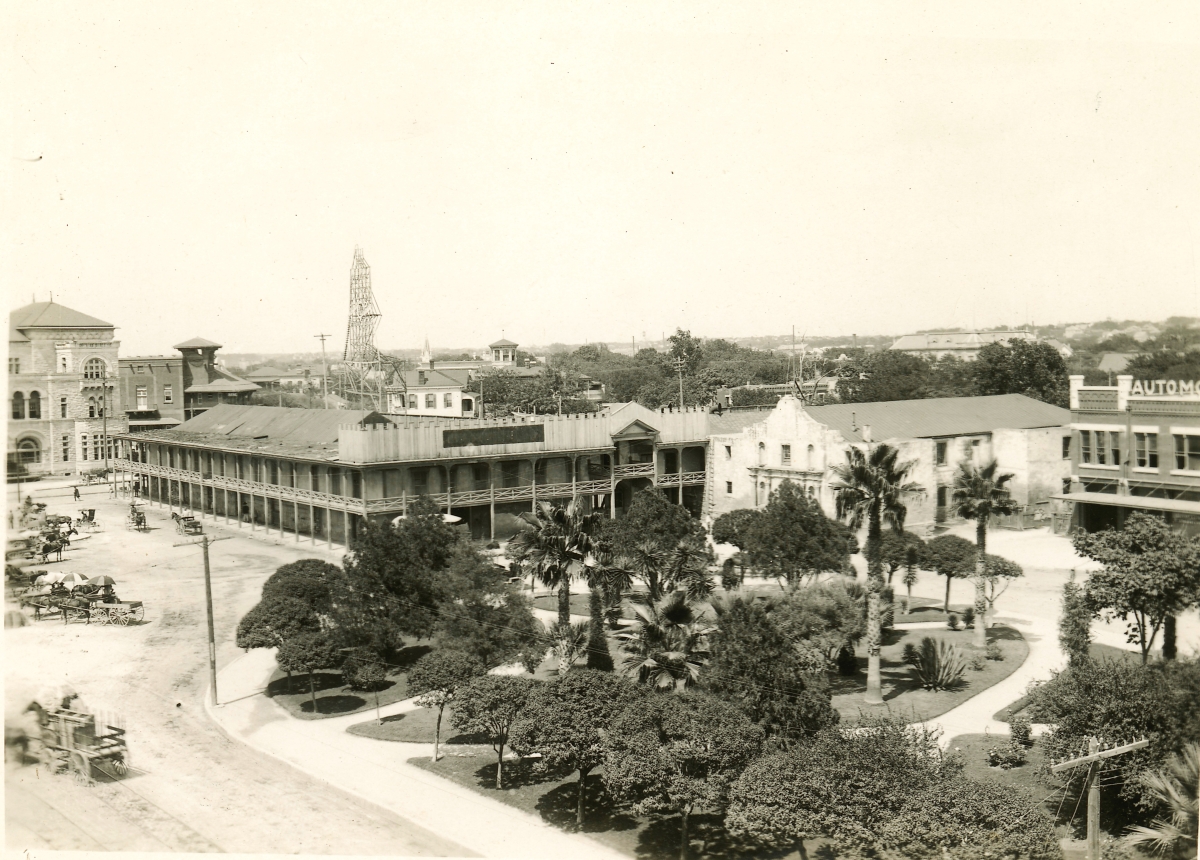
A photograph of Alamo Plaza from approximately 1910, showing the Hugo & Schmeltzer building attached to the Alamo church. Adina Emilia De Zavala Papers, The Dolph Briscoe Center for American History, The University of Texas at Austin.
And things have changed?
They have dramatically scaled down their ambitions. The current proposal is to spend $250 million to convert the surrounding buildings – those originally slated for tear down, the Woolworth building included – to house the museum. One big complaint is this Cenotaph, a huge and ugly monument, will not be moved. And that seems to have settled down the militiamen who said they were going to shoot anyone that tried to move it. There’s a new executive director at the Alamo, a former H-E-B grocery store executive. The grocery chain, based in San Antonio, is a potential donor to the museum. No one will commit to telling the whole story. George P. Bush is still saying the Alamo is about the battle, that’s where all the focus will be. Of course, Native Americans and Mexican Americans and the city of San Antonio are still up in arms demanding something different. The hope is that the scaled down ambition will get donors interested in it again. The donors I’ve spoken to say they don’t want their names on a monument to white supremacy, which is what we’re afraid will happen unless someone speaks out and promises to tell the whole and accurate story instead of repeating the myth of the Alamo.
The museum is not yet built and the collection not yet installed, but you expect a revisionist approach to the programming. Why is that?
Originally, the redevelopment of Alamo Plaza was going to involve state authorities, city authorities and the Daughters of the Republic of Texas, who were the keepers of the Alamo. Then you have the Native Americans, whose ancestors are buried in front of the Alamo underneath the city street. Then you have the African Americans, who wanted to recreate a lunch counter they had desegregated across the street in an old Woolworth building. Everyone got together and seemed convinced they could do this, they could make this a redevelopment that included all 300 years of the history – not just 13 days – and all of their agreements were based on that concept. Politics intervened when George P. Bush, who initially thought this was a good idea, realized he could lose his seat on the Land Commission in the Republican primary. He went hard right to save his political skin, adopting the Anglo narrative approach again. All the other groups, including the city, are annoyed and feel betrayed. They’re pressuring Bush, now that he’s trying to get elected as Attorney General, to go back to the original script. I think we’re going to get there, because the city of San Antonio wants that and the majority of Texans want that. One of the largest problems with the Alamo Foundation is the group of armed militiamen that show up in front of the location once a month saying they’re going to defend the legend of the Alamo. And that’s a real threat – that’s scary.
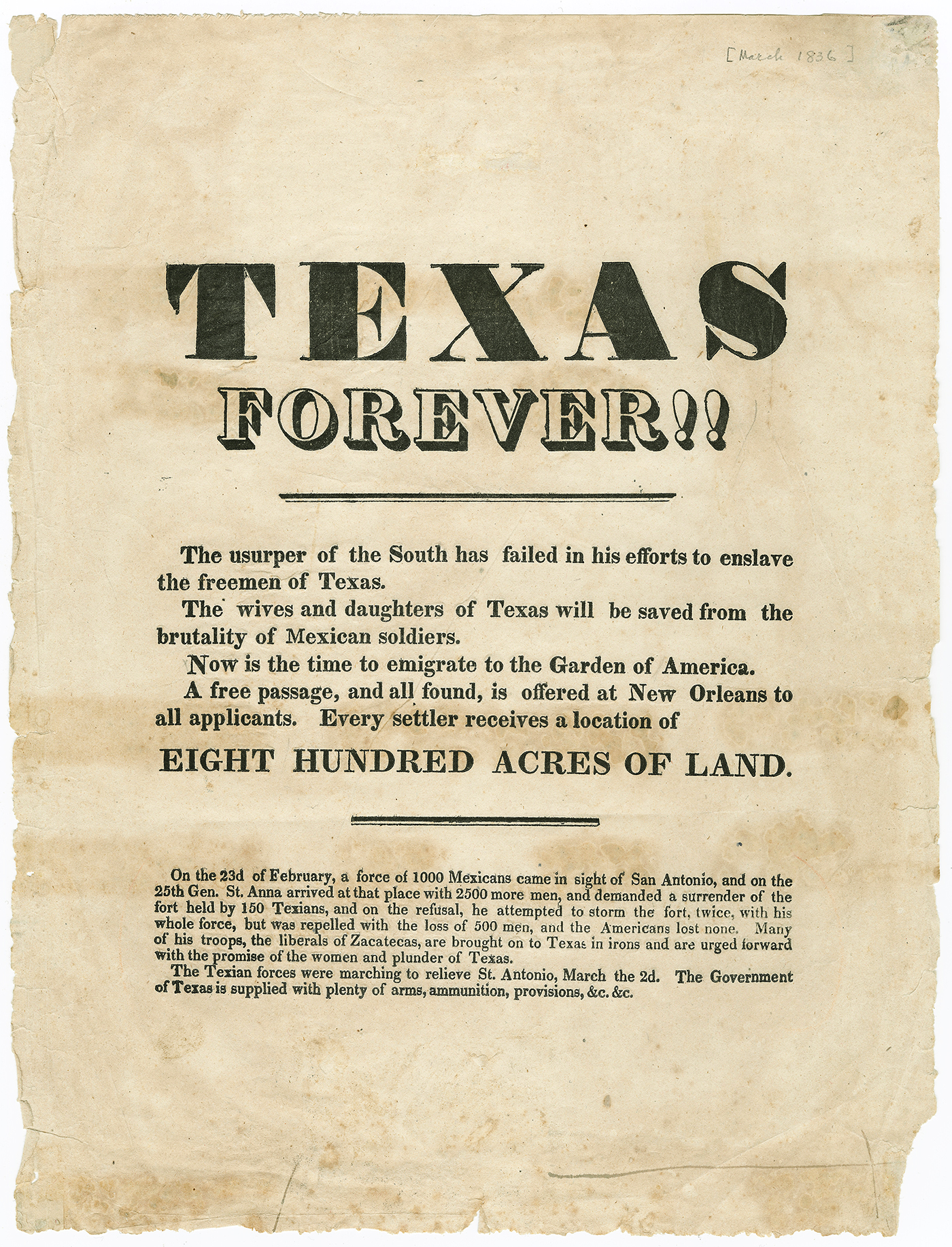
A flyer used to recruit white men from the South to join the Texas Revolt. Broadside Collection,The Dolph Briscoe Center for American History, The University of Texas at Austin.
Every month?
On average. They don’t have a set schedule, but once a month there will be an Alamo story in the newspaper and they’ll be out there the next day.
Why did the Alamo museum project become political theater?
Lots of angles. You have the Daughters of the Republic of Texas, who were the custodians of the Alamo for 100 years before Bush kicked them out for mismanagement. They were taking political revenge on him among members of the Republican party. You have a fraternal Texas organization that believes the myths and the legends are more important than the facts so as to instill patriotic values in young Texans. And this is tied up with conservative opposition to critical race theory. We weren’t calling it that two or four years ago, but it’s the same thing. It’s the idea that these cherished stories among conservative Republicans are important. When Bush initially talked about “reimagining the Alamo,” they saw him as a threat to traditional Texas culture. Bush needed to prove to the Republican primary voter that he was going to uphold their traditions and their values. Now that he’s running for a higher office, for Attorney General, he still needs to be seen as an ally to the right wing. Which is why he’s pro-Trump, anti-revisionism, it’s why he says the things he does. In Texas, the only election that counts in the Republican primary. If you can win that, you’re a shoo-in. There’s no upside for him to be anything but a traditionalist.
Alright, let’s get on to Phil Collins. What’s his deal, anyway? The British pop musician Phil Collins and the Alamo seem like a surreal match.
This is why no one should let their children watch Walt Disney films. When Phil was 5 years old, he saw Walt Disney’s Davey Crockett: King of the Wild Frontier, and he became obsessed with the Alamo. He recognized the story of people dying for a cause so that others may live. He’s told many news organizations how he drew the Alamo façade on his garden wall outside of London with his toy soldiers fighting the battle. When he became wealthy and successful, one of his wives bought him a letter connected to the Alamo and he started collecting here and there. Then when he retired from singing, he decided to devote himself to buying everything he possibly could from the Alamo. And he did, he bought everything that came up at auction and employed pickers to go out and find stuff for him – that’s where the trouble began.
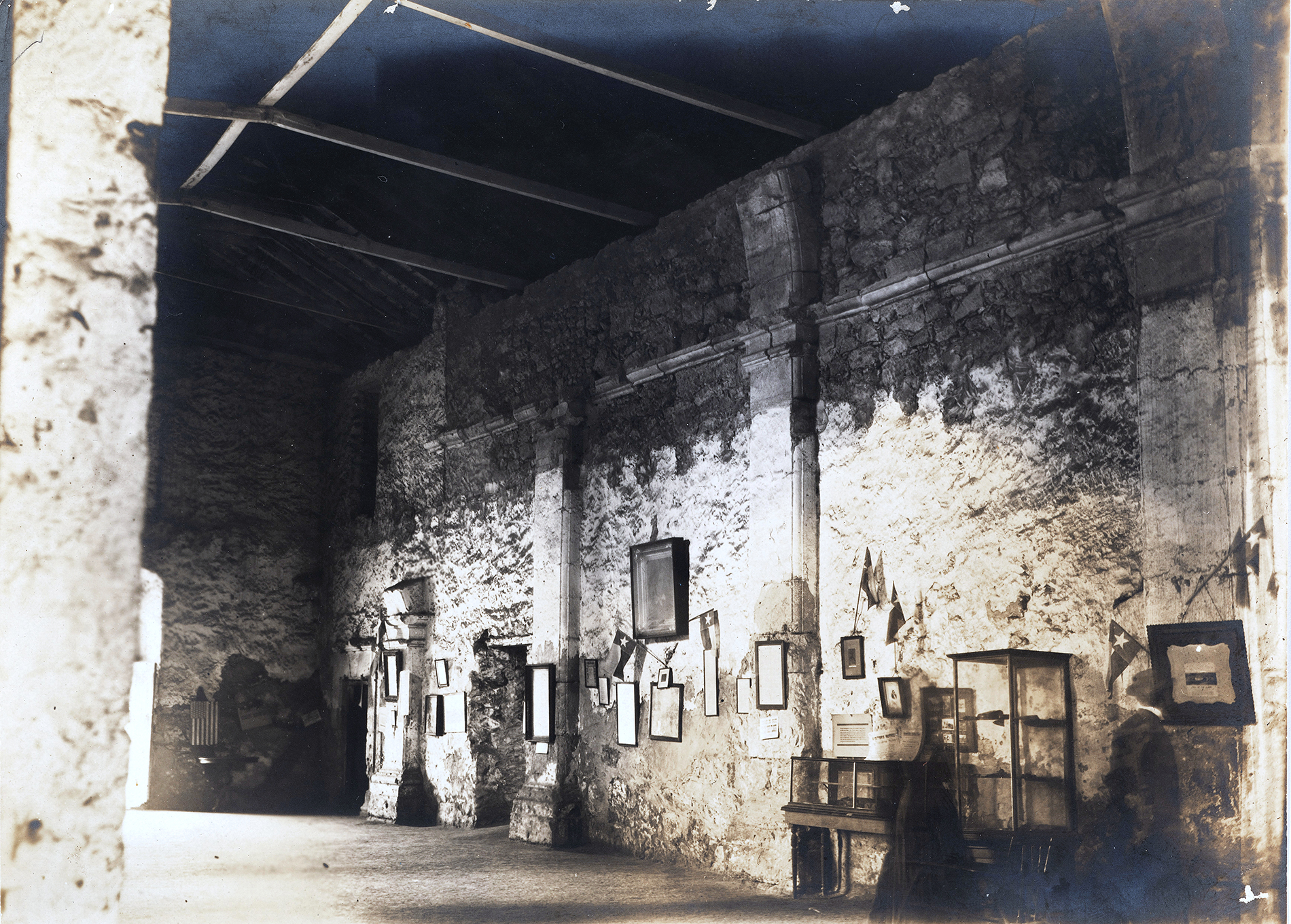
A photo of the interior of the Alamo church from the 1910s. Adina Emilia De Zavala Papers, The Dolph Briscoe Center for American History, The University of Texas at Austin.
Do you think the dealers who sold to him were credible authorities?
I don’t know where you go to school to have your expertise validated. One of these men, Jim Guimarin, ran a souvenir shop near the Alamo. It was high-end, you could buy guns and knives that were from that period, and also a Mexican uniform button or an old bronze bullet – bronze indicating that it had come from Mexico and not the United States where we used lead. Phil wandered in there one day and said, ‘if you ever come across anything, call me.’ Jim did not study history, he didn’t study archeology or art history, he was completely self-taught. He made his main income from restoring antique books. He had a guy working in the shop named Alex McDuffie, and Alex was kind of ne’er-do-well. He was not a good student by his own admission. He also read a book about the Alamo when he was a kid and became obsessed with it, he hoped to take over Jim’s shop one day. So when Phil opened that door, Jim just unleashed Alex onto the world to find whatever he could. I extensively interviewed Alex, he insists everything he found meets his standards for authenticity. The problem is Jim’s and Alex’s standards for provenance are not what are normally accepted by professional institutions. As a result, its more folkloric and some would say fraudulent. I can’t make that statement, but their critics do accuse them of fraud.
Where did Alex look?
He bought a lot of items that are related to the Texas Revolution, but not necessarily Alamo-related, through reputable auction houses. The items we have real problems with, the ones with the weakest provenance, he bought from other dealers.
There’s a saber in Collins’ collection from Alex, it is clearly from the period – indisputably. But then while that item is in Alex’s possession, he applies some gun oil and reveals an engraving that suddenly connects that item to the Alamo. Since only one outside expert has examined these items since that engraving has been revealed, it’s hard to know whether or not it’s authentic. Most of these items have no paper trail beyond one person before Alex or Jim.
There’s also something called the Joe Musso Bowie knife, now in the possession of the state of Texas, thanks to Collins. The editor of Knife Magazine says that knife and one other are fakes created by Dickie Washer in London. Dickie made a lot of these knives and they’re all over the world. On the other hand, going through the authentication papers that Collins provided to the state, the Musso knife is authenticated by at least three psychics. That was authentication enough for Phil Collins.
So the standards aren’t terribly high?
No, and that’s what we discovered going through volumes of paperwork given by Collins to the state. Almost none of the items he attributes to the Alamo can be properly authenticated.

Clara Driscoll, the savior of the Alamo, who worked to turn the area into a park. By Greuiee, Adina Emilia De Zavala Papers, The Dolph Briscoe Center for American History, The University of Texas at Austin.
I read in your book that Collins is unhappy his collection has come under scrutiny.
Right. We contacted him several times and his pickers asked Collins to talk to us. He refused and declined four times to be interviewed. But he did send emails to the general Land Office complaining about us. He also gave a quote to Texas Monthly years ago where he was furious at the writer for questioning the authenticity of just one item. He has threatened to take his collection back. Part of that is because the Land Office was behind on development of the museum they had promised him. We were also putting the pressure on him to prove his collection was what he said it was. I think, like anyone, he does not want to admit he was fooled.
Any indication on his current relationship with Jim and Alex?
The last message I received from Alex was a copy and pasted message that he sent to Phil and Jim saying he was going to sue us and asking them if they would like to join him in the lawsuit. No one has sued us, we have not been contacted by any attorneys. He’s got a year to file. I know Alex claims to still be in touch with Phil, but I have no idea if Phil is responding.
Do you believe the Alamo Museum will be a credible institution?
If it takes five or six years to build the museum, which I suspect it might, then yes, I think there’s a chance to build a legitimate institution. But it will require a political change in leadership because it will be a state institution. It is being overseen by an elected official. I also think they’ll have a hard time raising money from donors unless they make a commitment to a multicultural, multi-perspective institution. Yes, there are a few Texas billionaires who are Davey Crockett fans, but I don’t think they want their names associated with an institution that prizes white supremacy. I would also point out that this is the third serious attempt since the 1970s to redo Alamo Plaza. All of those failed and there’s a real possibility this one will too.
[Ed Note: Forget The Alamo: The Rise and Fall of an American Myth is out through Penguin Press and available on Amazon for $19.20 hardcover.]-Greg Smith


